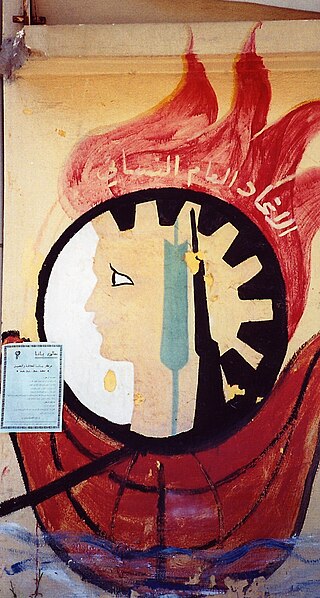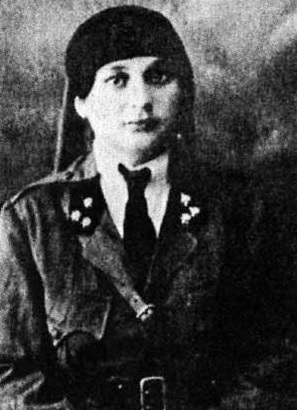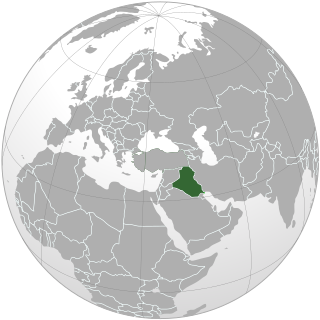Related Research Articles

The General Union of Syrian Women (GUSW) was founded in 1967 with Saud al Abdallah serving as the original president. It aimed to mobilize women while developing their education, political activism, and skills to help women become more effective members in socio-economic settings. While Syrian women have historically held more rights when compared to the rest of the Arab world, the GUSW is working to put an end to the isolation and marginalization of Syrian women, and help women to become more effective participants in Syrian society. This movement was born out of the unification of various welfare associations, volunteer organizations, and welfare groups caused by various political shifts in Syria.

Women in Lebanon are treated according to patriarchal norms although the legal status of women has improved since the 20th century. Gender equality in Lebanon remains problematic. Active feminist movements exist in Lebanon which are trying to overcome the legal and sociopolitical discrimination enshrined in law.

Naziha Jawdet Ashgah al-Dulaimi was an early pioneer of the Iraqi feminist movement. She was a co-founder and the first president of the Iraqi Women's League, the first woman minister in modern Iraq history, and the first woman cabinet minister in the Arab world.
The Women's National Committee of Yemen is a government-affiliated body working to empower women. Local Yemenis work on the committee in coordination with national and international partners to safeguard women's fundamental human rights. The Millennium Development Goals provide the framework guiding the committee's main policy priority areas.
The history of Middle Eastern newspaper publishing goes back to the 19th century. The Nahda was an important period for the development of newspaper publishing in the Middle East. During this period, a shift from government and missionary publishing to private publishing occurred. Especially in Egypt and Lebanon, newspapers became intertwined with daily life. Consequently, the rise of newspaper publishing impacted nationalism in Arab countries.

Nazik Al Abid known as the "Joan of Arc of the Arabs" was a Syrian women's rights activist, nationalist, and critic of Ottoman and French colonialism in Syria. She was the first woman to earn rank in the Syrian Army for her role in forming the Red Star Society, a precursor to the International Red Cross and Red Crescent Movement, during the battle of Maysalun. She was a revolutionary for national independence and women's right to work and vote in Syria.

Amatalrauf "Raufa Hassan" al-Sharki was an educator, feminist and human rights activist from Yemen. She was a professor of mass media and the director of a Women's Studies Center at the University of Sana'a. Al-Sharki was the first female journalist in Yemen and wrote a regular newspaper column for many years.
Amal Muhammad 'Ali al-Shami (1956–2001) was a Yemeni writer.
Nour Haidar was a twentieth-century pioneer of girl's education in Yemen.
Mahiya Najib (1926-1982), was a Yemeni women's rights activist, editor and journalist. She founded Fatat Shamsan [The Maiden of Mount Shamsan] in 1960, making her Aden's first female editor of a women's monthly magazine.
First Eastern Women's Congress, also known as First General Congress of Oriental Women and First Oriental Women's Congress was an international women's conference which took place in Damascus in Syria between 3 July and 10 July 1930. The conference was arranged by the General Union of Syrian Women under the leadership of Nour Hamada, with participants from the Arab World and Eastern Asia.
General Union of Yemeni Women (GUYW) was a women's organization in South Yemen, founded in 1968. It belonged to the National Liberation Front (South Yemen) (NLF) during the regime of People's Democratic Republic of Yemen.

The Iraqi Women's Union (IWU) was a women's advocacy group founded in 1945 which lasted until the Iraqi government crackdown on leftist organizations in the late 1950s. Throughout the course of its operation, the IWU focused on advocating on behalf of key women's issues regarding education, marriage rights, and labour rights, while equally engaging in charitable social work first hand. Due to the political climate in Iraq at the time, the union is known for having heavily antagonized male traditionalists while simultaneously retaining close ties to the political elite. The organization built its foundation upon other female advocacy groups which had emerged prior in the Middle East, and acted as a coordinating body for these other groups' activities. The growth of the union was further catalyzed during the late 1940s as female advocacy groups had gained prominence during the Second World War.
In June 1935 protests erupted across Lebanon and Syria. The protests were organised in response to the announcement by French colonial authorities of the establishment of a new tobacco monopoly under the Regie. Groups from across society participated in the protests, including students, tobacco workers, feminist groups, leftist organisations and members of the Maronite community. The protests not only voiced economic grievances but took on an anti-imperial tone and expressed national political frustration that cut across all groups in society. The tobacco protests in Lebanon were not necessarily an exceptional event for the time period as protests and revolts had characterized many of the areas of the region in the early 20th century. In fact during 1935 there were a number of other notable protests including tribal revolts in the Middle Euphrates, the student Wafd protests in Egypt, and also the concurrent tobacco protests in Syria.
Yemeni Women's Association (YWA) was a women's organization in North Yemen. Founded in 1965, as part of the emergence of the women's movement in North Yemen, it merged in 1990 with South Yemen's General Union of Yemeni Women (established 1968) to form the Yemeni Women's Union.
Adeni Women's Club was a women's organization in Yemen, founded in 1943. It was the first organisation of women's rights in Yemen, and the beginning of the women's rights movement in Yemen.
The Lebanese Council of Women or Lebanese Women's Council (LWC) is a women's organization in Lebanon, founded in 1952. It is an umbrella organization for the Lebanese women's movement.
Labibah Thabit, was a Lebanese women's rights activist. She was a pioneer figure of feminism in her country.
Laure Thabet (1896-1981), was a Lebanese women's rights activist. She was a pioneer figure of feminism in her country.
Radhia Ihsan (1933-2020), was a Yemeni women's rights activist, Politician and author.
References
- ↑ Intellectuals and Civil Society in the Middle East: Liberalism, Modernity and Political Discourse. (2012). Storbritannien: Bloomsbury Publishing. p.29-51
- ↑ Arenfeldt, Pernille; Al-Hassan Golley, Nawar (2012). Mapping Arab Women's Movements: A Century of Transformations from Within. New York, NY: The American University in Cairo. ISBN 978-977-416-498-9.
- Pernille Arenfeldt, Nawar Al-Hassan Golley, Mapping Arab Women's Movements: A Century of Transformations from Within
- https://civilsociety-centre.org/content/women%E2%80%99s-union-lebanon-and-syria
- James A. Reilly, Fragile Nation, Shattered Land: The Modern History of Syria
- Elizabeth Thompson, Colonial Citizens: Republican Rights, Paternal Privilege, and Gender in